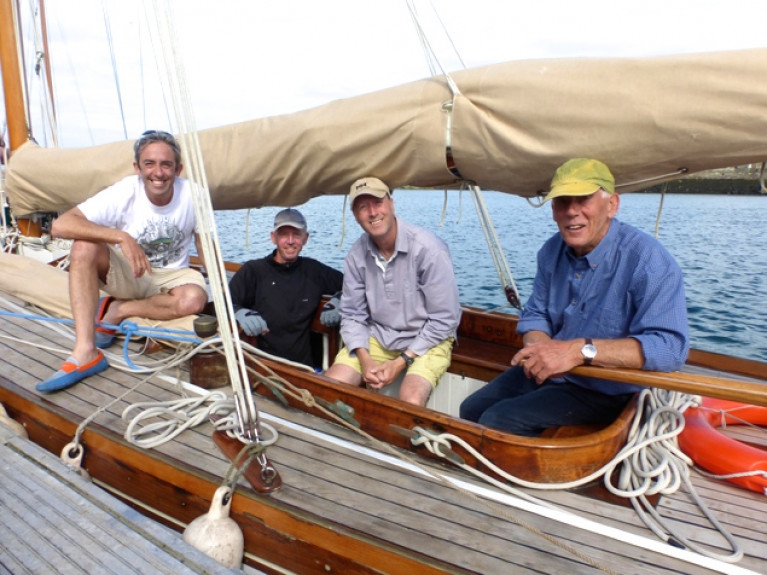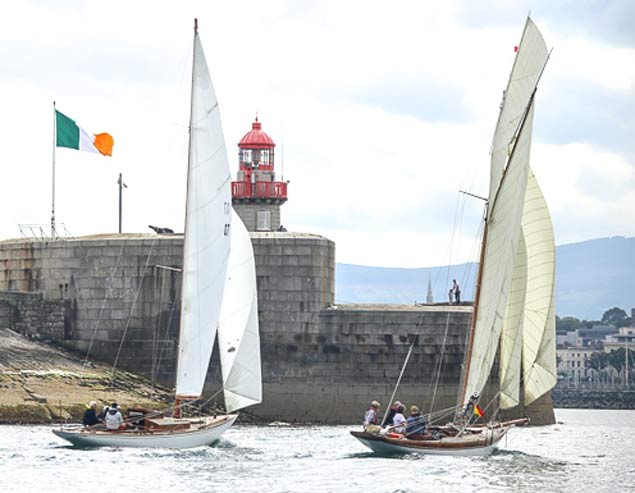The memorable Dun Laoghaire Regatta of 2017 included celebrations for the Bicentenary of the great harbour, and the Kingstown 200 Trophy in its honour became something very special for racing among the Classics writes W M Nixon.
In a popular decision, the trophy was awarded to the beautifully-restored 1897-vintage 37ft cutter Myfanwy from Milford Haven in Wales. Thanks to a four-year re-building project by her veteran owner Rob Mason – a retired tugboat captain – Myfanwy had emerged from near-dereliction to become a vision of elegance that sails very well.
She is a classic yacht very much of the Irish Sea, originally built by Sam Bond at his renowned yard at Birkenhead on the River Mersey to the designs of Alexander Richardson (1845-1915) of Liverpool. For a couple of decades around the mid to late 1800s, Liverpool was one of the wealthiest cities in the world, and for a brief period it supported its own nationally-recognised yacht designer in Alexander Richardson, who is probably best known for his creation in 1884 of the all-conquering cutter Irex for Dublin whiskey magnate John Jameson.
Part of Myfanwy’s attraction is that Richardson seems to have been given a free hand in the project to create his own vision of what a perfect yacht should look like, for she is an almost-indulgent symphony of sweeping curves which are skillfully combined to provide a yacht of speed and style – arguably, she is his best-looking boat.
 Myfanwy’s crew in Dun Laoghaire Harbour are (left to right) Max Mason, Gus Stott, Andy Whitcher, and owner Rob Mason who restored the 1897 classic in a four year project. Photo: W M Nixon
Myfanwy’s crew in Dun Laoghaire Harbour are (left to right) Max Mason, Gus Stott, Andy Whitcher, and owner Rob Mason who restored the 1897 classic in a four year project. Photo: W M Nixon
In the days of her prime when based in the Menai Straits, she was unbeatable. Nevertheless when Rob Mason, his son Max, and shipmates Andy Whitcher and Gus Stott brought her over to Dun Laoghaire early in July last year to race in the Classics Division in VDLR 2017, she looked so interestingly beautiful that no-one would have minded too much if she’d only had an average performance by comparison with more modern classics. But she went like the wind, and at times was more than holding her own with the restored Dublin Bay 24 Periwinkle, a Bermudan-rigged design of 1938.
For Rob Mason, winning the Kingstown 200 trophy successfully rounded out his involvement with Myfanwy, for already he was thinking in terms of a more comfortable vintage motor-fishing yacht, and as mentioned in Afloat, he found exactly what he wanted with the 1938-built Blue Hills, which when new was originally based in Mulroy Bay in Donegal under the ownership of Frank Gilliland.
The acquisition of Blue Hills (now undergoing another of Rob Mason’s restorations) reinforced the decision to sell Myfanwy. But with such a unique boat, you need a new owner who will truly appreciates what he or she is getting. This has now happened, and any day now Myfanwy will be road-trailed to a specialist boatyard in Cornwall where she will be “purged” of standard modern fittings such as Tufnol blocks in order to comply with the requirements of CIM (Comite International de la Mediterranee).
Since 1926, CIM has been the final arbiter as to what constitutes an authentic classic yacht, and by the season of 2019, Myfanwy will be Mediterranean-based and racing to CIM rules. But for now, she leaves behind the fondest memories in Dublin Bay
 Memories of a great regatta. Perwinkle and Myfanwy neck-and-neck at the entrance to Dun Laoghaire Harbour during VDLR 2017. Photo: Afloat.ie/David O’Brien
Memories of a great regatta. Perwinkle and Myfanwy neck-and-neck at the entrance to Dun Laoghaire Harbour during VDLR 2017. Photo: Afloat.ie/David O’Brien































































